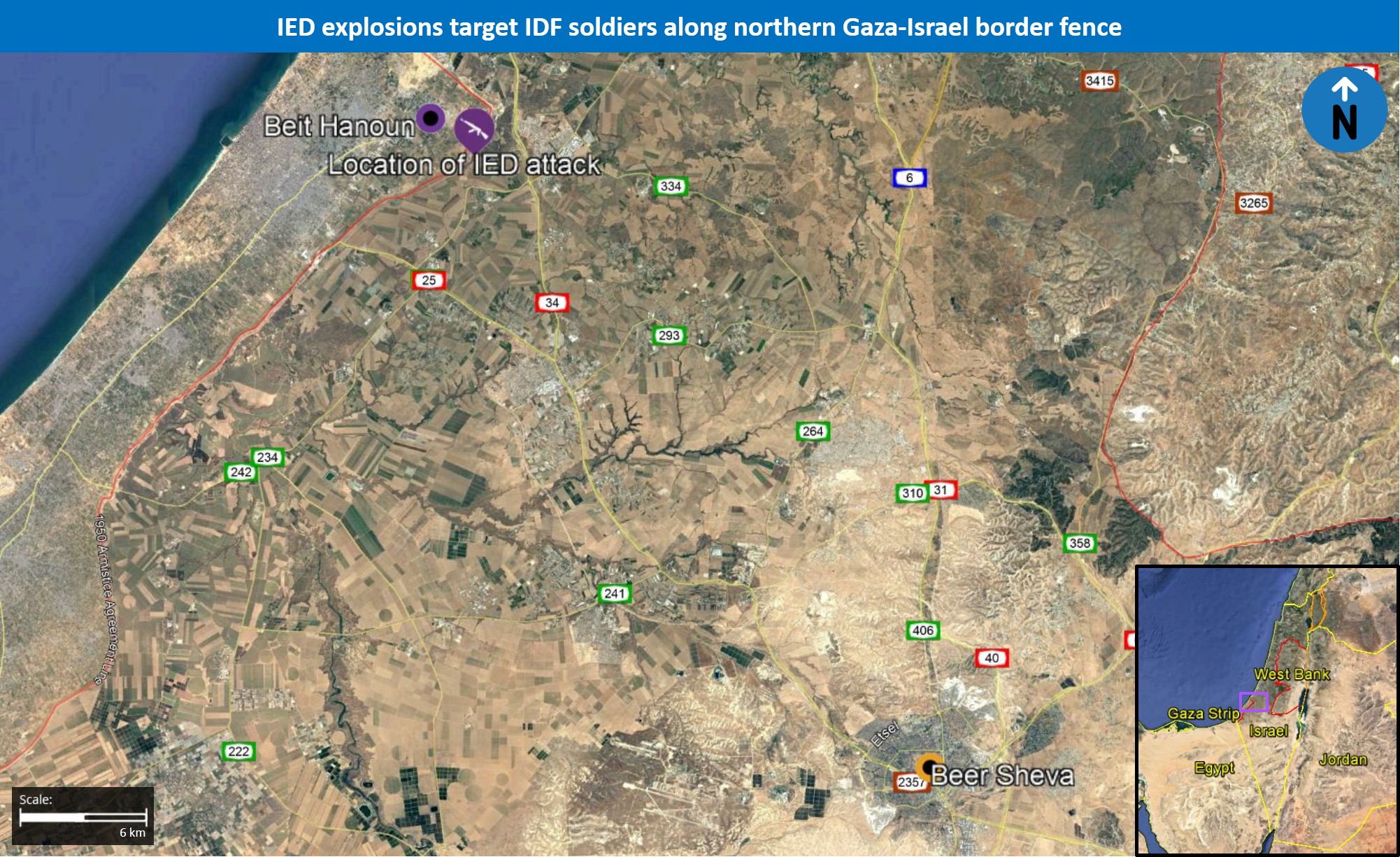15
Mar 2018
13:39 UTC
Israel & Palestinian Territories Alert: Two IED explosions target Israel Defense Forces (IDF) soldiers along northern Gaza-Israel border fence on March 15
Please be advised
- According to the Israel Defense Forces (IDF), two IED explosions targeted IDF soldiers along the northern Gaza-Israel border fence at an area east of Beit Hanoun during the morning hours of March 15. No casualties were recorded as a result of the attack.
- Reports indicate that a protest was recorded in the same area during the evening hours of March 14.
- In response, the IDF carried out tank fire against five Hamas positions in the northern Gaza Strip.
- According to further reports, the IDF targets included two observation posts, and an outpost belonging to Hamas in the northern Gaza Strip.
- Additional reports quoting the IDF Spokesperson state that the IDF is investigating the possibility that an anti-tank missile was fired at the forces.
Assessments & Forecast
- The incident is notable given that while such IED detonations are not unprecedented, they have remained relatively rare along the Gaza-Israel border over the past years. In this context, the most recent militancy-related incident involving the use of IEDs along the Gaza-Israel border fence took place on February 17, when an IED attack wounded four IDF soldiers in the area, and in March 2017, when the IDF reportedly identified and defused two IEDs placed in the area.
- While the perpetrators of the attack remain unknown at the time of writing, given the relative sophistication of the incident, we assess that one of the more established militant groups operating in the Gaza Strip, such as the Popular Resistance Committees or the Popular Front for the Liberation of Palestine (PFLP), were likely responsible for the attack. This is further likely if it would be confirmed that the attack involved an anti-tank missile. By carrying out such attacks, these factions likely seek to denounce Israel’s perceived oppressive policies towards the Palestinians in the Gaza Strip, namely the ongoing blockade. That said, there still remains a possibility that the attack was launched by hawkish elements within Hamas or the Palestinian Islamic Jihad (PIJ), who are discontent with their groups’ perceived ineffectiveness in confronting Israel.
- Regardless of the identity of the perpetrators of the attack, the incident likely highlights a recent trend of militants’ exploitation of the disarray caused by the frequent protests along the Gaza-Israel border to place an IED. This is further illustrated by the reports concerning a demonstration taking place at the locale of the attack on March 14, as well as the similarities to the February 17 event. Furthermore, the fact that the perpetrators were able to plant the device at the Gaza-Israel border fence underscores our previous assessment that Hamas has potentially relaxed its previous efforts to prevent militants in Gaza from targeting Israel. Given that Israel holds Hamas responsible for all attacks launched from the Gaza Strip, an attack at this time would elevate tensions between Israel and Hamas, and such a measured increase of tensions and hostilities with Israel would serve to divert the Gazan populace’s attention from internal issues, including the economic crisis, that are liable to further erode the legitimacy of Hamas’ governance.
- FORECAST: That said, Hamas and Israel remain uninterested in an escalation of hostilities into a broader conflict at this time. Meanwhile, although further IDF strikes targeting militant infrastructure in the Gaza Strip cannot be ruled out over the coming hours and days, any such action will remain localized and target weapons storages and lightly-manned security posts. It also remains possible that Gaza-based Salafist militant and Islamic State (IS)-inspired groups will increase their efforts to fire rockets into southern Israel over the coming days. This is an attempt to drag Israel and Hamas into a broad conflict, while capitalizing on the increase in tensions and Israel’s ongoing policy of holding Hamas responsible for every security incident emanating from the Gaza Strip. In any case, Israel will likely boost its security protocols along the Gaza-Israel border as a precautionary measure. This will likely include a heightened presence of IDF troops in the region, as well as additional deployments of the Iron Dome anti-missile defense system to the vicinity of major cities across southern Israel over the coming days.
Recommendations
Recommendations: Israel
- Travel to Israel may continue at this time while adhering to security precautions regarding militant attacks, while avoiding the immediate vicinity of the Syrian, Lebanese, and Egyptian borders, due to the persistent risk for cross border violence.
- Those traveling in the 40 km area surrounding the Gaza Strip should continue adhering to all safety precautions regarding early warning sirens for incoming rockets. In case you hear a siren, seek shelter in a protected area and remain inside for at least 10 minutes.
Recommendations: Palestinian Territories
- We advise against all travel to the Gaza Strip at this time due to continuous border crossing closures and the threat of militant activity. Those operating or residing in the Gaza Strip are advised to initiate contingency and emergency evacuation plans due to deterioration in the security situation. Contact us for itinerary and contingency support options.
- If travel is unavoidable, avoid one km from the border fence with Israel, due to the risk of cross border violence.
COUNTRY RISK LEVEL
High
AFFECTED AREA
Beit Hanoun; Gaza Strip; Israel
INCIDENT RISK LEVEL
Extreme
STRENGTH OF SOURCE
Confirmed
Please be advised
- According to the Israel Defense Forces (IDF), two IED explosions targeted IDF soldiers along the northern Gaza-Israel border fence at an area east of Beit Hanoun during the morning hours of March 15. No casualties were recorded as a result of the attack.
- Reports indicate that a protest was recorded in the same area during the evening hours of March 14.
- In response, the IDF carried out tank fire against five Hamas positions in the northern Gaza Strip.
- According to further reports, the IDF targets included two observation posts, and an outpost belonging to Hamas in the northern Gaza Strip.
- Additional reports quoting the IDF Spokesperson state that the IDF is investigating the possibility that an anti-tank missile was fired at the forces.
Assessments & Forecast
- The incident is notable given that while such IED detonations are not unprecedented, they have remained relatively rare along the Gaza-Israel border over the past years. In this context, the most recent militancy-related incident involving the use of IEDs along the Gaza-Israel border fence took place on February 17, when an IED attack wounded four IDF soldiers in the area, and in March 2017, when the IDF reportedly identified and defused two IEDs placed in the area.
- While the perpetrators of the attack remain unknown at the time of writing, given the relative sophistication of the incident, we assess that one of the more established militant groups operating in the Gaza Strip, such as the Popular Resistance Committees or the Popular Front for the Liberation of Palestine (PFLP), were likely responsible for the attack. This is further likely if it would be confirmed that the attack involved an anti-tank missile. By carrying out such attacks, these factions likely seek to denounce Israel’s perceived oppressive policies towards the Palestinians in the Gaza Strip, namely the ongoing blockade. That said, there still remains a possibility that the attack was launched by hawkish elements within Hamas or the Palestinian Islamic Jihad (PIJ), who are discontent with their groups’ perceived ineffectiveness in confronting Israel.
- Regardless of the identity of the perpetrators of the attack, the incident likely highlights a recent trend of militants’ exploitation of the disarray caused by the frequent protests along the Gaza-Israel border to place an IED. This is further illustrated by the reports concerning a demonstration taking place at the locale of the attack on March 14, as well as the similarities to the February 17 event. Furthermore, the fact that the perpetrators were able to plant the device at the Gaza-Israel border fence underscores our previous assessment that Hamas has potentially relaxed its previous efforts to prevent militants in Gaza from targeting Israel. Given that Israel holds Hamas responsible for all attacks launched from the Gaza Strip, an attack at this time would elevate tensions between Israel and Hamas, and such a measured increase of tensions and hostilities with Israel would serve to divert the Gazan populace’s attention from internal issues, including the economic crisis, that are liable to further erode the legitimacy of Hamas’ governance.
- FORECAST: That said, Hamas and Israel remain uninterested in an escalation of hostilities into a broader conflict at this time. Meanwhile, although further IDF strikes targeting militant infrastructure in the Gaza Strip cannot be ruled out over the coming hours and days, any such action will remain localized and target weapons storages and lightly-manned security posts. It also remains possible that Gaza-based Salafist militant and Islamic State (IS)-inspired groups will increase their efforts to fire rockets into southern Israel over the coming days. This is an attempt to drag Israel and Hamas into a broad conflict, while capitalizing on the increase in tensions and Israel’s ongoing policy of holding Hamas responsible for every security incident emanating from the Gaza Strip. In any case, Israel will likely boost its security protocols along the Gaza-Israel border as a precautionary measure. This will likely include a heightened presence of IDF troops in the region, as well as additional deployments of the Iron Dome anti-missile defense system to the vicinity of major cities across southern Israel over the coming days.
Recommendations
Recommendations: Israel
- Travel to Israel may continue at this time while adhering to security precautions regarding militant attacks, while avoiding the immediate vicinity of the Syrian, Lebanese, and Egyptian borders, due to the persistent risk for cross border violence.
- Those traveling in the 40 km area surrounding the Gaza Strip should continue adhering to all safety precautions regarding early warning sirens for incoming rockets. In case you hear a siren, seek shelter in a protected area and remain inside for at least 10 minutes.
Recommendations: Palestinian Territories
- We advise against all travel to the Gaza Strip at this time due to continuous border crossing closures and the threat of militant activity. Those operating or residing in the Gaza Strip are advised to initiate contingency and emergency evacuation plans due to deterioration in the security situation. Contact us for itinerary and contingency support options.
- If travel is unavoidable, avoid one km from the border fence with Israel, due to the risk of cross border violence.


